Time is pressing. My brother Vinny and sister-in-law Aileen are coming to visit later this month and there’s still a whole pile of work needing to be finished before we can take a break. (This read true when I started writing the log a couple of weeks ago: they’re actually arriving tomorrow!)
We’re gradually heading south west across Utah and as always, feel delighted to be back in the land of red rock. I briefly visited Canyonlands earlier in the summer whilst Sterling was in San Francisco but can’t turn down the opportunity to return given we’re so close.
 We need to make some serious headway with the work and so stop at Creek Pasture, a free BLM campground, just a few miles outside the park. We work during the day and in the evenings sit outside watching the canyon walls gradually change from their customary orange through ever darkening shades to a rich red, at which point the sun sets leaving them suddenly bereft and looking slightly two dimensional in the growing dusk. It’s very quiet and as the bats emerge in considerable numbers, we start to hear the rapid clicks of their sonar.
We need to make some serious headway with the work and so stop at Creek Pasture, a free BLM campground, just a few miles outside the park. We work during the day and in the evenings sit outside watching the canyon walls gradually change from their customary orange through ever darkening shades to a rich red, at which point the sun sets leaving them suddenly bereft and looking slightly two dimensional in the growing dusk. It’s very quiet and as the bats emerge in considerable numbers, we start to hear the rapid clicks of their sonar.
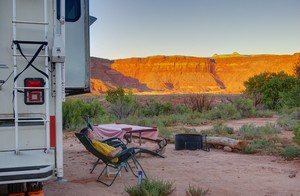 Edging one side of the campground is a wash, mainly dry except for a few pools lying in the lower depressions and an occasional patch of delightful red sandy mud that coats our shoes, as we follow the waterway on a late afternoon walk. Whilst we’re here, the aftermath of Hurricane Norbert starts to sweep across Utah and whilst little falls on us initially, we can see the heavy clouds dropping their loads in the distance and by the following morning the wash is flowing with a reasonable volume of water.
Edging one side of the campground is a wash, mainly dry except for a few pools lying in the lower depressions and an occasional patch of delightful red sandy mud that coats our shoes, as we follow the waterway on a late afternoon walk. Whilst we’re here, the aftermath of Hurricane Norbert starts to sweep across Utah and whilst little falls on us initially, we can see the heavy clouds dropping their loads in the distance and by the following morning the wash is flowing with a reasonable volume of water.
After a wet night at Needles Outpost, we head into the national park and the following day go out on the trails. We plan to follow Big Spring Canyon to its head, climbing up and over the wall separating it from the adjacent Squaw Canyon and come back round to the campground, a distance of about nine miles. It’s a fantastic route and a challenge for those of us with a fear of heights.
 My memory of doing this hike back in 2002 is that the descent into Squaw Canyon was the problem. Not the case this time round. On the way up, the route cuts horizontally across one of the faces: not good. The only thing is to lower my centre of gravity and proceed in what I call crustacean mode: back to the rock, hands and feet moving me slowly sideways. I’m sure it looks hilarious but it’s the only way I’m getting over this stretch. As it turns out, this is the worst of it, the route down has been changed and is fine. Reading the 2002 log, I suspect I will never learn. I always think I’ll be able to do ‘it’ and most times that’s true but the fear doesn’t decrease, I’m just loath to let it stop me.
My memory of doing this hike back in 2002 is that the descent into Squaw Canyon was the problem. Not the case this time round. On the way up, the route cuts horizontally across one of the faces: not good. The only thing is to lower my centre of gravity and proceed in what I call crustacean mode: back to the rock, hands and feet moving me slowly sideways. I’m sure it looks hilarious but it’s the only way I’m getting over this stretch. As it turns out, this is the worst of it, the route down has been changed and is fine. Reading the 2002 log, I suspect I will never learn. I always think I’ll be able to do ‘it’ and most times that’s true but the fear doesn’t decrease, I’m just loath to let it stop me.
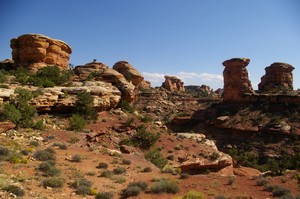 A short bike ride at the end of work the following day brings home just how unfit I am. With his achilles’ tendon unhappy from our hike, Sterling is finding the bike easier going than walking and scootles off up the long gradual hills with little problem. I’m the one huffing and puffing, grinding away in the lowest gear I’ve got, legs shaky when I stop. We need more time in the saddle, it’s the only way to build up the stamina. The effort is worth it for the views and the very short walk across the slickrock at Pothole Point. It’s a few days since the rain and one of the pothole pools is teaming with life. It’s a race against time. The pools are host to several types of shrimp and tiny spadefoot toad tadpoles: their life cycle must be complete before the water evaporates into the desert air.
A short bike ride at the end of work the following day brings home just how unfit I am. With his achilles’ tendon unhappy from our hike, Sterling is finding the bike easier going than walking and scootles off up the long gradual hills with little problem. I’m the one huffing and puffing, grinding away in the lowest gear I’ve got, legs shaky when I stop. We need more time in the saddle, it’s the only way to build up the stamina. The effort is worth it for the views and the very short walk across the slickrock at Pothole Point. It’s a few days since the rain and one of the pothole pools is teaming with life. It’s a race against time. The pools are host to several types of shrimp and tiny spadefoot toad tadpoles: their life cycle must be complete before the water evaporates into the desert air.
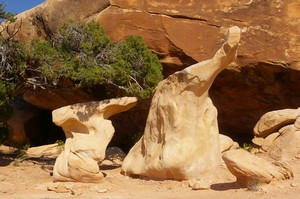
Moab beckons and we head into town for a couple of nights. The fresh water tank is due for a sanitize and so we need a hook-up for the long laborious process of flushing after the bleach solution has done its job. There’s a laundry in the campground so that’s my other big task of the day whilst Sterling makes some headway making Wearable Widgets work on the Moto 360 smartwatch that we’ve had delivered here. By the time evening comes round we’re ready for a well deserved dinner and a pint at the Moab Brewery.
Utah Licensing laws have changed since I last commented on this topic in 2002: it’s now possible to carry your own drink from the bar through to the restaurant and if you should so want, have a second drink served before you’ve drained the last drops from the first, unless both are spirits in which case it’s still a no-no. In spite of these relaxations in the Utah liquor laws, they remain some of the most restrictive in the States. Supermarkets can only sell 3.2% beer, anything else has to be bought from the state owned liquor store.
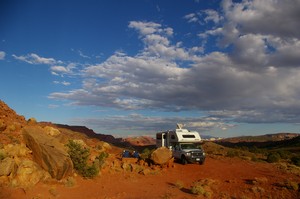 The draught beer sold at the brewery is also only 3.2% whereas the bottles and cans for takeout are considerably higher in alcohol content. The Trippel for example is 8.59% ABV. Presumably, drinking in public is more frowned upon than guzzling at home: appearances are everything.
The draught beer sold at the brewery is also only 3.2% whereas the bottles and cans for takeout are considerably higher in alcohol content. The Trippel for example is 8.59% ABV. Presumably, drinking in public is more frowned upon than guzzling at home: appearances are everything.
Capitol Reef National Park is our next stop and we arrive late in the afternoon to find the campground full. This is something of a surprise: the last two times we’ve been here it’s been deserted although admittedly neither has been in the high season. There’s some BLM land, with stunning views, just outside the park and we decide to stay for a couple of nights to press on with the work before heading back into the park.
 Unfortunately, our time in the park is gobbled up by more pressing work and we have little opportunity to get out and about other than a couple of very short walks. This disappointment is somewhat offset by being here in the autumn: the hard-fruit orchards, dating back to the days of settlement in the bottom of the valleys, are ready for picking. For a nominal sum, we pick apples using a long handled picker: they are small, crisp and tasty. Maybe not quite as nice as the Coxes and Worcesters we used to grow in my family’s garden but enjoyable nevertheless.
Unfortunately, our time in the park is gobbled up by more pressing work and we have little opportunity to get out and about other than a couple of very short walks. This disappointment is somewhat offset by being here in the autumn: the hard-fruit orchards, dating back to the days of settlement in the bottom of the valleys, are ready for picking. For a nominal sum, we pick apples using a long handled picker: they are small, crisp and tasty. Maybe not quite as nice as the Coxes and Worcesters we used to grow in my family’s garden but enjoyable nevertheless.
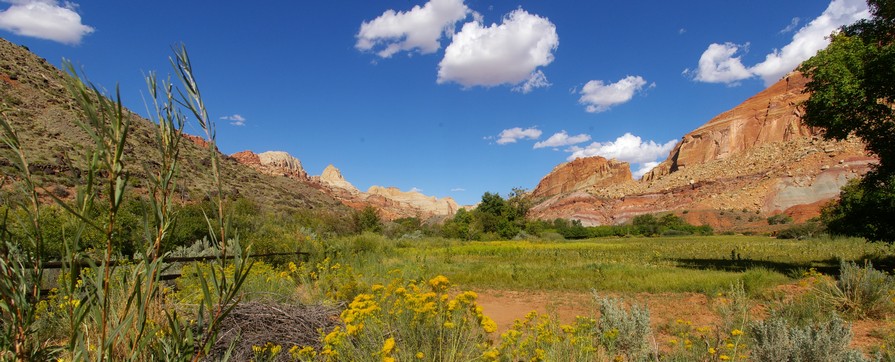 The fees charged in the national park campgrounds are always of interest to us and we’re often at a loss to explain the differences. Earlier in the year, we stayed at Wind Cave National Park over the Memorial Day weekend for a fee of $18 a night. The campground was nearly empty inspite of the holiday weekend. When we suggested to a ranger that maybe if they lowered the price, it would be busier, we were assured that cost was not the issue: apparently, people just don’t like to camp any longer. We didn’t like to point out our overwhelming experience of full campgrounds elsewhere in the country. Another example is Mesa Verde where we stayed last month. It’s one of the worst national park campgrounds we’ve ever stayed in: poor facilities and infrastructure but charging the princely sum of $30 plus for one night on a dry site. This is another very underused campground. And then we have campgrounds like the one at Capitol Reef. Since we were last here the campground’s had a makeover: the sites are well spaced, the pads paved, there are good fire-rings or grills and the setting is wonderful with plenty of big cottonwoods for shade. It’s $10 and is full by 11.30 am in season. They could probably double the price and still have the demand.
The fees charged in the national park campgrounds are always of interest to us and we’re often at a loss to explain the differences. Earlier in the year, we stayed at Wind Cave National Park over the Memorial Day weekend for a fee of $18 a night. The campground was nearly empty inspite of the holiday weekend. When we suggested to a ranger that maybe if they lowered the price, it would be busier, we were assured that cost was not the issue: apparently, people just don’t like to camp any longer. We didn’t like to point out our overwhelming experience of full campgrounds elsewhere in the country. Another example is Mesa Verde where we stayed last month. It’s one of the worst national park campgrounds we’ve ever stayed in: poor facilities and infrastructure but charging the princely sum of $30 plus for one night on a dry site. This is another very underused campground. And then we have campgrounds like the one at Capitol Reef. Since we were last here the campground’s had a makeover: the sites are well spaced, the pads paved, there are good fire-rings or grills and the setting is wonderful with plenty of big cottonwoods for shade. It’s $10 and is full by 11.30 am in season. They could probably double the price and still have the demand.
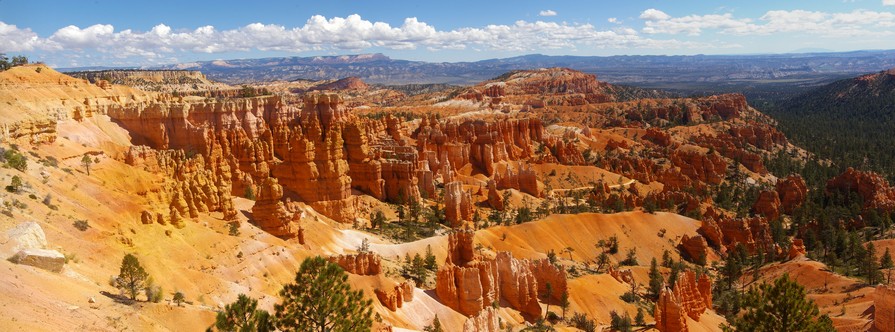
We’re also squeezing in a short stop at Bryce Canyon on our way to rendezvous with our visitors. It’s one of my favourite places in The States and I can’t imagine ever tiring of it. In between work, we make time for a short hike or two.
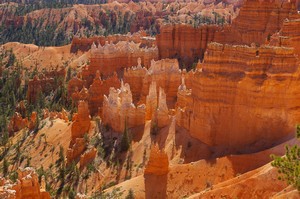 Looking down from the rim, the hoodoos stretch out through the canyon. The colours range from the palest yellows to the deepest reds, the effects of erosion clear in the walls of emerging hoodoos as much as in those left standing alone, separated from their neighbours. It’s a complex and intricate world of incredible beauty, its moods changing with the passing of the sun, indescribably stunning at sunset and sunrise, wonderful at any time. We’ve been here in snow, under overcast skies and in blazing sun: it’s always stunning.
Looking down from the rim, the hoodoos stretch out through the canyon. The colours range from the palest yellows to the deepest reds, the effects of erosion clear in the walls of emerging hoodoos as much as in those left standing alone, separated from their neighbours. It’s a complex and intricate world of incredible beauty, its moods changing with the passing of the sun, indescribably stunning at sunset and sunrise, wonderful at any time. We’ve been here in snow, under overcast skies and in blazing sun: it’s always stunning.
It is under stormy skies that we head down into the canyon early one evening. The colours may not be quite as vibrant under these conditions but it’s a delight to be down amongst the Ponderosas looking up at the free standing hoodoos and the canyon walls. The trails down in the canyon are a pleasure. They follow beside the dry washes along the canyon floor, wind through the distinctive features and pass through archways cut out by (who other than) the CCC.
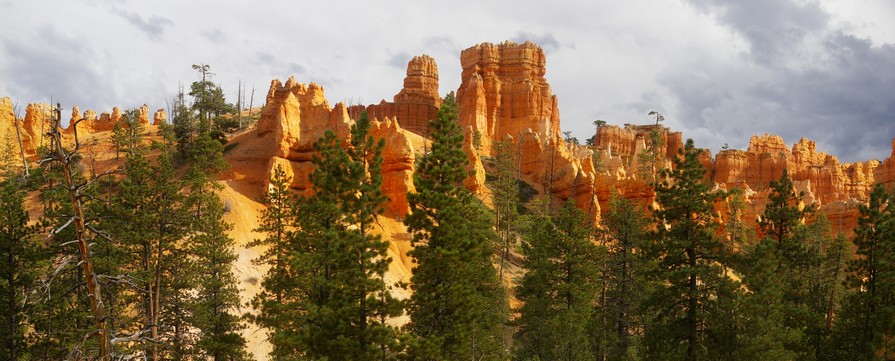
Down here the wide expanse of the canyon, as seen from the rim, is lost, replaced by a much more personal experience. We leave most people behind as we press further from the trail-head: the low rumble of voices on the rim fades and other than the occasional rustle of wind through the trees there is silence.
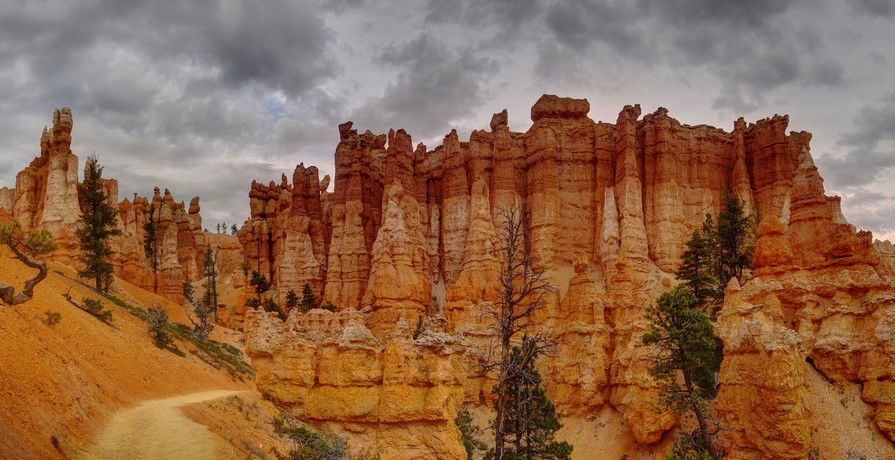 In the more enclosed areas where the trails cut through the towering crevices of red sandstone, even under these dull skies, the rock emanates a golden light that is almost tangible.
In the more enclosed areas where the trails cut through the towering crevices of red sandstone, even under these dull skies, the rock emanates a golden light that is almost tangible.
Our time here may be dominated by work but just a couple of hours in this fairyland make it worthwhile being here.